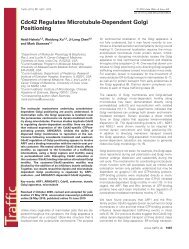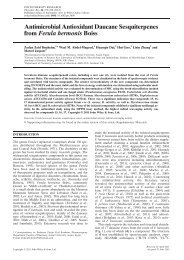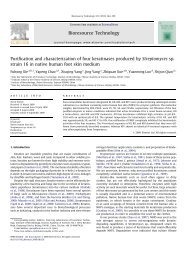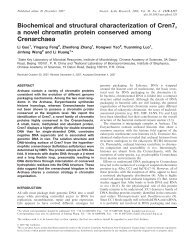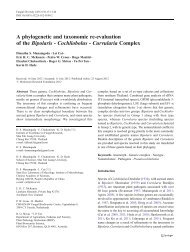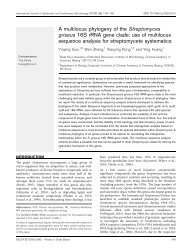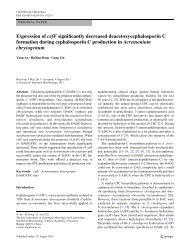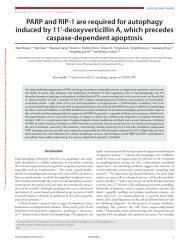Production and stability studies of the biosurfactant isolated from ...
Production and stability studies of the biosurfactant isolated from ...
Production and stability studies of the biosurfactant isolated from ...
Create successful ePaper yourself
Turn your PDF publications into a flip-book with our unique Google optimized e-Paper software.
Desalination 285 (2012) 198–204<br />
Contents lists available at SciVerse ScienceDirect<br />
Desalination<br />
journal homepage: www.elsevier.com/locate/desal<br />
<strong>Production</strong> <strong>and</strong> <strong>stability</strong> <strong>studies</strong> <strong>of</strong> <strong>the</strong> <strong>biosurfactant</strong> <strong>isolated</strong> <strong>from</strong> marine<br />
Nocardiopsis sp. B4<br />
A. Khopade a , R. Biao b , X. Liu b , K. Mahadik a , L. Zhang b , C. Kokare a,c, ⁎<br />
a Department <strong>of</strong> Pharmaceutical Biotechnology, Poona College <strong>of</strong> Pharmacy, Bharati Vidyapeeth Deemed University, Pune, 411 038, India<br />
b Chinese Academy <strong>of</strong> Science Key Laboratory <strong>of</strong> Pathogenic Microbiology <strong>and</strong> Immunology, Institute <strong>of</strong> Microbiology, Chinese Academy <strong>of</strong> Sciences, Beijing 100101, China<br />
c Department <strong>of</strong> Pharmaceutics, STES, Sinhgad Institute <strong>of</strong> Pharmacy, Narhe, Pune, 411 041, India<br />
article<br />
info<br />
abstract<br />
Article history:<br />
Received 7 June 2011<br />
Received in revised form 21 September 2011<br />
Accepted 4 October 2011<br />
Available online 9 November 2011<br />
Keywords:<br />
Biosurfactant<br />
Nocardiopsis<br />
Optimization<br />
Stability<br />
Actinomycetes<br />
A potential <strong>biosurfactant</strong> producing strain, marine Nocardiopsis B4 was <strong>isolated</strong> <strong>from</strong> <strong>the</strong> West coast <strong>of</strong> India.<br />
Culture conditions involving variations in carbon <strong>and</strong> nitrogen sources were examined at constant pH, temperature<br />
<strong>and</strong> revolutions per min (rpm), with <strong>the</strong> aim <strong>of</strong> increasing productivity in <strong>the</strong> process. The <strong>biosurfactant</strong><br />
production was followed by measuring <strong>the</strong> surface tension, emulsification assay <strong>and</strong> emulsifying<br />
index E24. Enhanced <strong>biosurfactant</strong> production was carried out using olive oil as <strong>the</strong> carbon source <strong>and</strong> phenyl<br />
alanine as <strong>the</strong> nitrogen source. The maximum production <strong>of</strong> <strong>the</strong> <strong>biosurfactant</strong> by Nocardiopsis occurred at a C/<br />
N ratio <strong>of</strong> 2:1 <strong>and</strong> <strong>the</strong> optimized bioprocess condition was pH 7.0, temperature 30°C <strong>and</strong> salt concentration<br />
3%. The production <strong>of</strong> <strong>the</strong> <strong>biosurfactant</strong> was growth dependent. The surface tension was reduced up to<br />
29 mN/m as well as <strong>the</strong> emulsification index E24 was 80% in 6 to 9 days. Properties <strong>of</strong> <strong>the</strong> <strong>biosurfactant</strong><br />
that was separated by acid precipitation were investigated. The <strong>biosurfactant</strong> activity was stable at high temperature,<br />
a wide range <strong>of</strong> pH <strong>and</strong> salt concentrations thus, indicating its application in bioremediation, food,<br />
pharmaceutical <strong>and</strong> cosmetics industries.<br />
© 2011 Elsevier B.V. All rights reserved.<br />
1. Introduction<br />
Research in <strong>the</strong> area <strong>of</strong> <strong>biosurfactant</strong>s has exp<strong>and</strong>ed in recent<br />
years due to its potential use in different areas, such as <strong>the</strong> food industry,<br />
agriculture, pharmaceuticals, oil industry, petro chemistry,<br />
paper <strong>and</strong> pulp industry. The development <strong>of</strong> this line <strong>of</strong> research is<br />
<strong>of</strong> paramount importance, mainly in view <strong>of</strong> <strong>the</strong> present concern regarding<br />
<strong>the</strong> protection <strong>of</strong> <strong>the</strong> environment. They are not only useful<br />
as antibacterial, antifungal <strong>and</strong> antiviral agents, but also have potential<br />
for use as major immunomodulatory molecules, anti-adhesive<br />
agents <strong>and</strong> even in vaccines <strong>and</strong> gene <strong>the</strong>rapy [1–4]. Involvement <strong>of</strong><br />
<strong>biosurfactant</strong>s in microbial adhesion <strong>and</strong> desorption has been widely<br />
described. For example, inhibition <strong>of</strong> uropathogen bi<strong>of</strong>ilm formation<br />
on silicone rubber by protein-like <strong>biosurfactant</strong>s obtained <strong>from</strong><br />
Lactobacillus fermentum RC-14 was reported [1]. Also, exposure to<br />
suspensions <strong>of</strong> active probiotics <strong>and</strong> <strong>the</strong> consumption <strong>of</strong> buttermilk<br />
containing Lactococcus lactis 53 were reported to influence <strong>the</strong><br />
bi<strong>of</strong>ilm formation on silicone rubber voice pros<strong>the</strong>ses [1], possibly<br />
due to <strong>the</strong> release <strong>of</strong> <strong>biosurfactant</strong>s. Biosurfactants, are produced by<br />
bacteria or yeast <strong>from</strong> various substrates including sugars, glycerol,<br />
oils, hydrocarbons <strong>and</strong> agricultural wastes. Biosurfactants are<br />
⁎ Corresponding author at: Department <strong>of</strong> Pharmaceutics, STES, Sinhgad Institute <strong>of</strong><br />
Pharmacy, Narhe, Pune, 411 041, India. Tel.: +91 20 66831806; fax: +91 20 24699051.<br />
E-mail address: kokare71@rediffmail.com (C. Kokare).<br />
classified as glycolipids, lipopeptides, phospholipids, fatty acids, neutral<br />
lipids, <strong>and</strong> polymeric or particulate compounds [2,5]. The hydrophobic<br />
portion <strong>of</strong> <strong>the</strong> molecule is long-chain fatty acids, hydroxyl<br />
fatty acids or a-alkyl-b-hydroxyl fatty acids. The hydrophilic moiety<br />
can be a carbohydrate, amino acid, cyclic peptide, phosphate, carboxylic<br />
acid or alcohol. Biosurfactants have been receiving increasing attention<br />
as a result <strong>of</strong> <strong>the</strong>ir unique properties, i.e. mild production<br />
conditions, lower toxicity <strong>and</strong> higher biodegradability, compared to<br />
<strong>the</strong>ir syn<strong>the</strong>tic chemical counterparts [3]. Even though interest in <strong>biosurfactant</strong>s<br />
is increasing, <strong>the</strong>se compounds do not compete economically<br />
with syn<strong>the</strong>tic surfactants. To reduce production costs, different<br />
routes could be investigated such as <strong>the</strong> increase <strong>of</strong> yields <strong>and</strong> product<br />
accumulation; <strong>the</strong> development <strong>of</strong> economical engineering<br />
processes <strong>and</strong> <strong>the</strong> use <strong>of</strong> cost-free or cost credit feedstock for microorganism<br />
growth <strong>and</strong> surfactant production. The choice <strong>of</strong> inexpensive<br />
raw materials is important to overall economy <strong>of</strong> <strong>the</strong> process because<br />
<strong>the</strong>y account for 50% <strong>of</strong> <strong>the</strong> final product cost <strong>and</strong> also reduce <strong>the</strong><br />
expenses with wastes treatment [1,6,7]. Glycolipid <strong>from</strong><br />
Rhodococcus erythropolis, R. aurantiacus <strong>and</strong> surface active lipid <strong>from</strong><br />
Nocardia erythropolis were studied in <strong>the</strong> literature survey. There<br />
are very few reports on <strong>biosurfactant</strong>s production <strong>from</strong> marine<br />
actinomycetes [6].<br />
The objective <strong>of</strong> present study was to isolate marine actinomycetes<br />
<strong>and</strong> <strong>the</strong> identification <strong>of</strong> strain for potent <strong>biosurfactant</strong><br />
production. The cultural conditions for maximum production <strong>of</strong><br />
<strong>biosurfactant</strong> <strong>and</strong> <strong>the</strong> <strong>stability</strong> study <strong>of</strong> <strong>the</strong> product were investigated.<br />
0011-9164/$ – see front matter © 2011 Elsevier B.V. All rights reserved.<br />
doi:10.1016/j.desal.2011.10.002
A. Khopade et al. / Desalination 285 (2012) 198–204<br />
199<br />
2. Material <strong>and</strong> methods<br />
2.1. Isolation <strong>of</strong> actinomycetes strain B4<br />
Marine sediment sample was collected <strong>from</strong> Mumbai coastal region<br />
<strong>of</strong> India at <strong>the</strong> time <strong>of</strong> low tide [8]. Collected sediment sample<br />
was suspended in sterile water <strong>and</strong> mixed on rotary incubator shaker<br />
(New Brunswick Scientific, Model Excella E24, USA), at 150 rpm for<br />
20 min. Different marine actinomycete species were <strong>isolated</strong> by<br />
using selective media such as glycerol yeast extract agar, starch casein<br />
agar, maltose yeast extract agar <strong>and</strong> glucose aspargine agar (Himedia,<br />
India). The <strong>isolated</strong> strains were screened for <strong>biosurfactant</strong> production<br />
by using different techniques [9–14]. Maximum <strong>biosurfactant</strong><br />
producing marine sp. B4 was maintained on glycerol yeast extract<br />
agar medium [15].<br />
2.2. Identification <strong>of</strong> strain B4<br />
Identification <strong>of</strong> strain was done by scanning electron microscopy<br />
(SEM) (Pune, India), 16S r-DNA sequencing, biochemical <strong>and</strong> cultural<br />
characterizations. The method adopted for preparation <strong>of</strong> slide culture<br />
for SEM analysis was used, as described by Williams <strong>and</strong> Davies<br />
[12,15–17].<br />
2.3. Inoculum preparation <strong>and</strong> culture condition<br />
The glycerol yeast extract medium prepared in artificial seawater<br />
(ASW) was used for development <strong>of</strong> inoculum. The seed culture<br />
was prepared in 100 ml conical flasks containing 50 ml <strong>of</strong> medium<br />
by inoculating 2.0 ml <strong>of</strong> spore suspension containing 2.5 to<br />
3.0×10 6 CFU ml −1 <strong>and</strong> cultivated with agitation (150 rpm) at 28 °C<br />
for 4 days. The seed culture (50 ml) was inoculated in <strong>the</strong> 1 l fermentation<br />
medium prepared in artificial sea water supplemented with<br />
0.1 ml trace element solution. The pH <strong>of</strong> <strong>the</strong> medium was adjusted<br />
to 7.0. Fermentation was carried out in 2 l bench scale fermenter<br />
(New Brunswick Scientific, USA) for 12 days. The operating conditions<br />
during batch fermentation were temperature 28 °C, agitation<br />
rate 150 rpm <strong>and</strong> <strong>the</strong> aeration rate 1.0 VVM [8].<br />
2.4. Medium optimization<br />
The medium optimization was conducted in a series <strong>of</strong> experiments<br />
changing one variable at a time, keeping o<strong>the</strong>r factors<br />
unchanged. The production <strong>of</strong> <strong>biosurfactant</strong> was growth dependent.<br />
Cell growth <strong>and</strong> <strong>the</strong> accumulation <strong>of</strong> metabolic products were strongly<br />
influenced by medium composition such as carbon sources, nitrogen<br />
sources. Three factors were chosen aiming to obtain higher<br />
productivity <strong>of</strong> <strong>the</strong> <strong>biosurfactant</strong>: carbon source (C), nitrogen source<br />
(N) <strong>and</strong> C/N ratio. The carbon sources used were n-hexadecane (2%<br />
w/v) (Himedia, India), olive oil (2% w/v) (commercial type), sucrose<br />
(Himedia, India), trehalose (Himedia, India), maltose (Himedia,<br />
India), dextrose <strong>and</strong> glucose (Himedia, India) (20 g/l), with ammonium<br />
chloride (NH 4 Cl) (Himedia, India) as nitrogen source. For evaluation<br />
<strong>of</strong> <strong>the</strong> most appropriate nitrogen sources for <strong>the</strong> production <strong>of</strong><br />
<strong>biosurfactant</strong>s, phenyl alanine (Himedia, India), urea (Himedia,<br />
India), ammonium sulfate (Merck, India), NH 4 Cl <strong>and</strong> sodium nitrate<br />
(NaNO 3 )(Merck, India), were employed at a concentration <strong>of</strong> 1 g/l<br />
with <strong>the</strong> optimum carbon source. The C/N ratio (with optimized<br />
carbon <strong>and</strong> nitrogen sources) was varied <strong>from</strong> 10 to 40 by keeping a<br />
constant nitrogen source concentration 1 g/l [18–21].<br />
2.5. Biosurfactant production kinetics<br />
The kinetics <strong>of</strong> <strong>biosurfactant</strong> production was followed in batch<br />
cultures during 12 days at optimum conditions by measuring surface<br />
tension <strong>and</strong> emulsification assay <strong>of</strong> supernatant samples obtained<br />
after cell separation [18,19].<br />
2.6. Effect <strong>of</strong> pH, temperature, sodium chloride <strong>and</strong> aeration on<br />
<strong>biosurfactant</strong> production <strong>and</strong> activity<br />
In order to evaluate <strong>the</strong> effect <strong>of</strong> pH <strong>and</strong> temperature on <strong>the</strong> <strong>biosurfactant</strong><br />
production, <strong>the</strong> pH <strong>of</strong> medium was adjusted in <strong>the</strong> range<br />
between 4 <strong>and</strong> 12 <strong>and</strong> <strong>the</strong> temperature was set at 4, 15, 25, 30, 35<br />
40, 45 <strong>and</strong> 60 °C. The pH <strong>of</strong> <strong>the</strong> medium was measured with a digital<br />
pH-meter (Systronics, India). To examine <strong>the</strong> effect <strong>of</strong> sodium chloride<br />
on <strong>biosurfactant</strong> production in optimized medium, <strong>the</strong> sodium<br />
chloride was added in medium to achieve final concentrations <strong>of</strong><br />
1–10% (w/v). Effect <strong>of</strong> aeration on production <strong>of</strong> <strong>biosurfactant</strong> was<br />
detected by incubating inoculated fermentation media at different<br />
aeration conditions such as 50, 75, 100, 125, 150, 175, 200, 225 <strong>and</strong><br />
300 rpm. Biosurfactant production was measured by emulsification<br />
assay <strong>and</strong> absorbance was measured at 400 nm [21].<br />
2.7. Effect <strong>of</strong> oils, surfactants <strong>and</strong> hydrocarbon on <strong>biosurfactant</strong><br />
production<br />
The effect <strong>of</strong> crude oil <strong>and</strong> surfactant was evaluated for <strong>biosurfactant</strong><br />
production. The different oils were used such as castor oil, codliver<br />
oil, eucalyptus oil, sesame oil, mustard oil <strong>and</strong> surfactants such<br />
as ethylene diamine tetra acetic acid (EDTA) (Himedia, India), cetyl<br />
trimethyl ammonium bromide (CTAB) (Himedia, India), sodium<br />
dodicyl sulfate (SDS) (Loba Chemie, India), tweens 20, 40, 80 (Loba<br />
Chemie, India) were added separately in 1% (v/v) <strong>and</strong> emulsification<br />
activity <strong>of</strong> medium was measured. The hydrocarbons such as diesel,<br />
petrol, toluene, xylene, n-hexane <strong>and</strong> kerosene (commercial grade,<br />
India) were added [1% (v/v)] separately in optimized medium <strong>and</strong><br />
<strong>the</strong>ir effect was observed. The surface tension measurement was carried<br />
out using <strong>the</strong> du Nouy ring method [6,8].<br />
2.8. Surface tension measurement<br />
The surface tension measurement <strong>of</strong> cell free supernatant was<br />
determined in a K6 tensiometer, using <strong>the</strong> du Nouy ring method.<br />
The values reported were <strong>the</strong> mean <strong>of</strong> three measurements. All measurements<br />
were made on cell-free broth obtained by centrifuging <strong>the</strong><br />
cultures at 10,000 rpm for 20 min [18].<br />
2.9. Bioemulsifier production assay<br />
Actinomycetes species were grown for 12 to 15 days in glycerol<br />
yeast extract (GYE) broth. The microbial cells were separated by centrifugation<br />
(Eppendorff, model 5810R, Germany) at 10,000 rpm for<br />
15 min at 30 °C. Cell free culture broth (3 ml) was added in 0.5 ml<br />
test oil, mixed vigorously for 2 min <strong>and</strong> incubated at 30 °C for 1 h<br />
for phase separation. Aqueous phase was removed carefully <strong>and</strong> absorbance<br />
<strong>of</strong> aqueous phase was recorded at 400 nm. The absorbance<br />
maxima arrived after scanning at entire visible light spectrum. The<br />
blank was prepared with sterile medium. An absorbance <strong>of</strong><br />
0.01 units at 400 nm multiplied by dilution factor, if any, was considered<br />
as one unit <strong>of</strong> emulsification activity per ml (EU/ml) [6].<br />
2.10. Emulsification index (E24)<br />
Emulsification index <strong>of</strong> culture samples was determined by adding<br />
2 ml <strong>of</strong> a hydrocarbon to <strong>the</strong> same amount <strong>of</strong> culture, mixing with a<br />
vortex for 2 min, <strong>and</strong> left st<strong>and</strong>ing for 24 h. The E24 index is given<br />
as percentage <strong>of</strong> height <strong>of</strong> emulsified layer (mm) divided by total<br />
height <strong>of</strong> <strong>the</strong> liquid column (mm) [9–11].
200 A. Khopade et al. / Desalination 285 (2012) 198–204<br />
2.11. Biosurfactant recovery<br />
Culture broth was centrifuged at 10,000 rpm for 20 min to get cell<br />
free broth. Biosurfactant was precipitated by adjusting <strong>the</strong> pH <strong>of</strong> <strong>the</strong><br />
cell free broth to 2.0 using 6 N hydrochloric acid (HCl) (Merck,<br />
India) <strong>and</strong> keeping it overnight at 4 °C. The precipitate thus formed<br />
was collected by centrifugation (10,000 rpm, 20 min; 4 °C) <strong>and</strong> dissolved<br />
in distilled water. Its pH was adjusted to 8.0 with 1 N sodium<br />
hydroxide (NaOH) (Qualigens, India), <strong>and</strong> <strong>the</strong> solution was lyophilized<br />
[18].<br />
2.12. Stability <strong>studies</strong><br />
To determine <strong>the</strong> <strong>the</strong>rmal <strong>stability</strong> <strong>of</strong> <strong>the</strong> <strong>biosurfactant</strong>, cell-free<br />
broth was maintained at a constant temperature range <strong>of</strong> 20–100 °C<br />
for 15 min, <strong>the</strong>n cooled to room temperature <strong>and</strong> activity <strong>of</strong> <strong>the</strong> <strong>biosurfactant</strong><br />
was investigated. To determine <strong>the</strong> effect <strong>of</strong> pH on activity,<br />
<strong>the</strong> pH <strong>of</strong> <strong>the</strong> cell free broth was adjusted to different values using 1 N<br />
NaOH or 1 N HCl. The effect <strong>of</strong> addition <strong>of</strong> different concentration <strong>of</strong><br />
NaCl on <strong>the</strong> activity <strong>of</strong> <strong>the</strong> <strong>biosurfactant</strong> was investigated. The <strong>biosurfactant</strong><br />
was re-dissolved after purification with distilled water containing<br />
<strong>the</strong> specific concentration <strong>of</strong> NaCl (0–9%, w/v) [22,23].<br />
3. Results <strong>and</strong> discussions<br />
The advantages <strong>of</strong> <strong>biosurfactant</strong>s over syn<strong>the</strong>tic ones include<br />
lower toxicity, biodegradability, selectivity, specific activity at extreme<br />
temperatures, pH <strong>and</strong> salinity. In our laboratory, we have<br />
<strong>isolated</strong> <strong>the</strong> strain <strong>of</strong> marine Nocardiopsis <strong>from</strong> sediments.<br />
3.1. Characterization <strong>of</strong> strain B4<br />
The strain B4 showed good growth in <strong>the</strong> temperature range<br />
25–45 °C in 7 days on glycerol yeast extract agar medium. Outer surface<br />
<strong>of</strong> colonies was perfectly round initially, but later <strong>the</strong>y developed<br />
aerial mycelium that may appear velvety <strong>and</strong> spore formation started<br />
after <strong>the</strong> 4th day <strong>of</strong> incubation. Spore chain was long <strong>and</strong> sporulating<br />
hyphae were straight. Spores were oval <strong>and</strong> warty, appeared like<br />
hairy <strong>and</strong> were 1–2.5 mm in size (Fig. 1A <strong>and</strong> 1B). Good growth was<br />
observed at neutral pH. By morphology, SEM <strong>and</strong> 16S DNA sequencing<br />
(Fig. 2), <strong>the</strong> <strong>isolated</strong> strain was found to be a member <strong>of</strong><br />
Nocardiopsis genus [8].<br />
3.2. Growth characteristics <strong>and</strong> <strong>biosurfactant</strong> production <strong>from</strong> strain B4<br />
Most <strong>of</strong> <strong>the</strong> actinomycetes species are slow-growing. Biosurfactant<br />
production started in early log phase but <strong>the</strong>re was drastic<br />
increase in production at late growth phase <strong>and</strong> early stationary<br />
phase; <strong>and</strong> <strong>biosurfactant</strong> production continued up to late stationary<br />
phase <strong>and</strong> after that it declined (Fig. 3). It clearly indicates that <strong>biosurfactant</strong><br />
production was dependent on <strong>the</strong> growth phase [8].<br />
3.3. Optimization <strong>of</strong> cultivation medium<br />
3.3.1. Effect <strong>of</strong> carbon source<br />
The production <strong>of</strong> <strong>biosurfactant</strong> was studied by using carbon<br />
sources such as n-hexadecane, olive oil, trehalose, sucrose, fructose,<br />
maltose <strong>and</strong> glucose (Fig. 4A). The use <strong>of</strong> vegetable oil as carbon<br />
sources to produce <strong>biosurfactant</strong>s seems to be an interesting <strong>and</strong><br />
low cost alternative [18]. Screening <strong>of</strong> nutrient substrates showed<br />
that Nocardiopsis supported growth on all substrates although <strong>the</strong><br />
yield was limited with galactose or starch as carbon sources because<br />
<strong>of</strong> inhibition due to <strong>the</strong> decrease in pH is probably caused by <strong>the</strong><br />
production <strong>of</strong> secondary acid such as uronic acid [18]. The maximum<br />
<strong>biosurfactant</strong> production was occurring only with trehalose, hexadecane<br />
<strong>and</strong> olive oil. The strain grew on starch but did not produce<br />
Fig. 1. Scanning electron microscopy <strong>of</strong> strain B4 [A] ×3000 magnification, <strong>and</strong><br />
[B] ×6000 magnification.<br />
<strong>the</strong> surfactant under <strong>the</strong>se conditions. Olive oil was <strong>the</strong> best carbon<br />
source for <strong>biosurfactant</strong> syn<strong>the</strong>sis. The <strong>isolated</strong> <strong>biosurfactant</strong> decreased<br />
<strong>the</strong> surface tension to 30 mN/m <strong>and</strong> <strong>the</strong> emulsifying activity<br />
was 80%. Similar results were found with <strong>biosurfactant</strong> production<br />
form P. aeruginosa 44T1 [24,25].<br />
3.3.2. Effect <strong>of</strong> nitrogen source<br />
The effect <strong>of</strong> nitrogen source affects <strong>the</strong> <strong>biosurfactant</strong> production<br />
as shown in Fig. 4B. Nocardiopsis sp. was able to use nitrogen sources<br />
such as ammonia <strong>and</strong> urea for <strong>biosurfactant</strong> production. However, in<br />
order to obtain high concentrations <strong>of</strong> <strong>biosurfactant</strong> it is necessary to<br />
have restrained conditions <strong>of</strong> <strong>the</strong>se macro-nutrients. Phenyl alanine<br />
was <strong>the</strong> best source <strong>of</strong> nitrogen for growth <strong>and</strong> <strong>biosurfactant</strong> syn<strong>the</strong>sis.<br />
Ammonium salts in <strong>the</strong> form <strong>of</strong> ammonium chloride were used<br />
for growth but not for <strong>biosurfactant</strong> production <strong>and</strong> caused a significant<br />
decrease in pH (4.03) [24,26,27]. The maximum emulsifying<br />
activity <strong>and</strong> minimal surface tension (30 mN/m) were reached in<br />
media with phenyl alanine. No significant change in pH was observed<br />
in this case. A similar result was reported in <strong>biosurfactant</strong> <strong>isolated</strong><br />
<strong>from</strong> Pseudomonas fluorescens by Abouseoud et al. [18].<br />
3.3.3. Effect <strong>of</strong> carbon/nitrogen ratio<br />
The fundamental aspect to <strong>the</strong> improvement <strong>of</strong> <strong>biosurfactant</strong> productivity<br />
was <strong>the</strong> ratio <strong>of</strong> C/N. These results were obtained using olive<br />
oil <strong>and</strong> phenyl alanine as carbon <strong>and</strong> nitrogen source respectively<br />
since <strong>the</strong> best results were attained with lower values <strong>of</strong> this parameter<br />
(C/N=20 ) (ST=30; EA=265 U/ml) (Fig. 4C). There were no<br />
significant differences between C/N ratios <strong>of</strong> 30, 35 <strong>and</strong> 40 in relation<br />
to emulsification index, but a C/N ratio <strong>of</strong> 20 presented a significant<br />
difference in relation to <strong>the</strong> emulsification index. These results are<br />
similar with those found using waste frying oil <strong>and</strong> sodium nitrate<br />
as carbon <strong>and</strong> nitrogen sources respectively [25–28]. Guerra-Santos<br />
et al. [29] observed that <strong>biosurfactant</strong> production was poor with
A. Khopade et al. / Desalination 285 (2012) 198–204<br />
201<br />
76<br />
76<br />
95<br />
99 Nocardiopsis exhalans ES10.1 T (AY036000)<br />
Nocardiopsis valliformis 20028 T (AY336503)<br />
Nocardiopsis metallicus KBS6 T (AJ420769)<br />
Nocardiopsis ganjiahuensis HBUM 20038 T (AY336513)<br />
Nocardiopsis prasina DSM 43845 T (X97884)<br />
Nocardiopsis listeri DSM40297 T (X97887)<br />
76<br />
Nocardiopsis alkaliphila DSM 44657 T (AY230848)<br />
B4<br />
Nocardiopsis alba DSM 43377 T (X97883)<br />
Nocardiopsis umidischolae 66/93 T (AY036001)<br />
100<br />
Nocardiopsis tropica VKM Ac -1457 T (AF105971)<br />
Marinactinospora <strong>the</strong>rmotoleransSCSIO 00652 T (EU698029)<br />
0.005<br />
Fig. 2. Neighbor-joining phylogenetic tree <strong>of</strong> strain B4 made by MEGA 4.0. Numbers at nodes indicate levels <strong>of</strong> bootstrap support (%) based on a neighbor-joining analysis <strong>of</strong> 1000<br />
resampled datasets; only values >50% are given. NCBI accession numbers are given in paren<strong>the</strong>ses. Bar, 0.005 nucleotide substitutions per site.<br />
both yeast extract <strong>and</strong> nitrate as nitrogen sources. When <strong>the</strong> yeast extract<br />
was omitted, <strong>the</strong> biomass concentration decreased, rhamnolipid<br />
increased <strong>and</strong> a moderate accumulation <strong>of</strong> glucose occurred, indicating<br />
a nitrogen-limiting medium.<br />
3.4. Kinetics <strong>of</strong> <strong>biosurfactant</strong> production<br />
The <strong>biosurfactant</strong> production <strong>and</strong> surface tension were dependent<br />
on growth <strong>of</strong> culture in <strong>the</strong> fermentation medium. The surface tension<br />
dropped rapidly after inoculation, reaching its lowest value<br />
(29 mN/m) during exponential phase after about 9 days <strong>of</strong> growth<br />
(Fig. 3A <strong>and</strong> Fig. 3B). The emulsification activity plot, a measure <strong>of</strong><br />
<strong>biosurfactant</strong> concentration, showed that insufficient surfactant was<br />
initially present to form micelles. At about 6th day <strong>of</strong> growth, <strong>the</strong> surfactant<br />
concentration started to increase, reaching its maximum after<br />
about 9th day. The increase in surface tension <strong>and</strong> <strong>the</strong> decrease in E24<br />
after 12th <strong>of</strong> incubation showed that <strong>biosurfactant</strong> biosyn<strong>the</strong>sis<br />
stopped <strong>and</strong> is probably due to <strong>the</strong> production <strong>of</strong> secondary metabolites<br />
which could interfere with emulsion formation <strong>and</strong> <strong>the</strong> adsorption<br />
<strong>of</strong> surfactant molecules at <strong>the</strong> oil–water interface [30]. These<br />
results indicate that <strong>the</strong> <strong>biosurfactant</strong> biosyn<strong>the</strong>sis <strong>from</strong> olive oil occurred<br />
predominantly during <strong>the</strong> exponential growth phase, suggesting<br />
that <strong>the</strong> <strong>biosurfactant</strong> is produced as primary metabolite<br />
accompanying cellular biomass formation (growth-associated kinetics)<br />
[31]. This property suggests that <strong>biosurfactant</strong> could be effectively<br />
produced under chemostat conditions or by immobilized cells<br />
[18,19,32,33].<br />
3.5. Effect <strong>of</strong> sodium chloride, pH, temperature <strong>and</strong> aeration on<br />
<strong>biosurfactant</strong> production<br />
The strain B4 was found to be moderately halophilic in nature as<br />
maximum <strong>biosurfactant</strong> production was obtained in presence <strong>of</strong> 3%<br />
Fig. 3. Growth kinetics <strong>and</strong> <strong>biosurfactant</strong> production <strong>of</strong> Nocardiopsis B4 sp. (OD600).<br />
(w/v) <strong>of</strong> NaCl <strong>and</strong> it retained almost 80% <strong>of</strong> its activity in presence<br />
<strong>of</strong> 12% (w/v) <strong>of</strong> NaCl. (Fig. 5A). The strain B4 showed gradual increase<br />
in <strong>biosurfactant</strong> production <strong>and</strong> optimum pH for <strong>biosurfactant</strong> production<br />
was found to be 7 (Fig. 5B). The research was focused on<br />
<strong>the</strong> isolation <strong>of</strong> alkaline <strong>biosurfactant</strong> <strong>from</strong> microbes because <strong>the</strong>re<br />
is tremendous potentiality <strong>of</strong> <strong>biosurfactant</strong> in detergent industry.<br />
The strain B4 showed good growth in <strong>the</strong> temperature range <strong>of</strong><br />
25–45 °C but optimum growth was observed at 30 °C (Fig. 5C). This<br />
clearly indicates <strong>the</strong> moderately <strong>the</strong>rmostable nature <strong>of</strong> <strong>the</strong> <strong>biosurfactant</strong>.<br />
The maximum <strong>biosurfactant</strong> production was obtained at<br />
150 rpm. Until today, bacteria belonging to genus Bacillus have been<br />
exploited for commercial production <strong>of</strong> <strong>biosurfactant</strong> [21,24]. There<br />
is no such report on isolation <strong>of</strong> moderately <strong>the</strong>rmostable surfactant<br />
<strong>from</strong> marine Nocardiopsis sp.<br />
3.6. Effect <strong>of</strong> oils, surfactants <strong>and</strong> hydrocarbons on production <strong>of</strong><br />
<strong>biosurfactant</strong><br />
Fermentation was carried out with addition <strong>of</strong> different concentrations<br />
<strong>of</strong> oils, surfactant <strong>and</strong> hydrocarbons in <strong>the</strong> fermentation medium.<br />
It was observed that olive oil, tween 80 <strong>and</strong> hexane as a<br />
substrate showed maximum activity against all test oils, surfactants<br />
<strong>and</strong> hydrocarbons respectively. Olive oil <strong>and</strong> tween 80 showed emulsification<br />
activity at 198 EU/ml <strong>and</strong> 225 EU/ml respectively (Fig. 6A<br />
<strong>and</strong> 6B). Hexane was used [6] as a substrate for <strong>biosurfactant</strong> production<br />
<strong>and</strong> it was observed that 1% v/v showed maximum <strong>biosurfactant</strong><br />
production activity (Fig. 6C).<br />
3.7. Stability study<br />
3.7.1. Temperature <strong>stability</strong><br />
The applicability <strong>of</strong> <strong>biosurfactant</strong>s in several fields depends on<br />
<strong>the</strong>ir <strong>stability</strong> at different temperatures <strong>and</strong> pH values. The <strong>stability</strong><br />
<strong>of</strong> <strong>biosurfactant</strong> was tested over a wide range <strong>of</strong> temperature. The<br />
<strong>biosurfactant</strong> produced by Nocardiopsis sp. was shown to be <strong>the</strong>rmostable<br />
(Fig. 7A). Heating <strong>of</strong> <strong>the</strong> <strong>biosurfactant</strong> to 100 °C caused no significant<br />
effect on <strong>the</strong> <strong>biosurfactant</strong> performance. The emulsification<br />
activity was quite stable at <strong>the</strong> temperatures used (E24=66%) in<br />
comparison with syn<strong>the</strong>tic surfactants such as SDS which exhibits a<br />
significant loss <strong>of</strong> emulsification activity beginning at 70 °C [31].<br />
Therefore, it can be concluded that this <strong>biosurfactant</strong> maintains its<br />
surface properties unaffected in <strong>the</strong> range <strong>of</strong> temperatures between<br />
30 <strong>and</strong> 100 °C. This activity was discovered indicating <strong>the</strong> usefulness<br />
<strong>of</strong> <strong>the</strong> <strong>biosurfactant</strong> in food, pharmaceutical <strong>and</strong> cosmetics industries<br />
where heating to achieve sterility is <strong>of</strong> paramount importance<br />
[18,25].
202 A. Khopade et al. / Desalination 285 (2012) 198–204<br />
Surface tension (mN/m)<br />
AEmulsification activity (EU/ml)<br />
E24 (%)<br />
B<br />
Surface tension (mN/m)<br />
C<br />
100<br />
80<br />
60<br />
40<br />
20<br />
0<br />
80<br />
60<br />
40<br />
20<br />
0<br />
Olive oil<br />
Galato se<br />
Ammo. sulphate<br />
300<br />
200<br />
100<br />
0<br />
Phenyl alanine<br />
Dextrose<br />
Strac h<br />
Mannitol<br />
Sucrose<br />
Trehalose<br />
Carbon sources<br />
Alanine<br />
Ammo. chloride<br />
Urea<br />
Nitrogen source<br />
Hexadecne<br />
Fructo se<br />
Maltose<br />
Aspargine<br />
Sodium nitrate<br />
Emlusification activity<br />
Surface tension<br />
10 15 20 25 30 35 40<br />
C:N ratio<br />
A<br />
Surface tension (mN/m)<br />
0 20 40 60 80<br />
B<br />
Surface tension (mN/m)<br />
C<br />
Surface tension (mN/m)<br />
80<br />
60<br />
40<br />
20<br />
0<br />
100<br />
80<br />
60<br />
40<br />
20<br />
0<br />
1 2 3 4 5 6 7 8 9 10<br />
NaCl (% w/v)<br />
4<br />
5<br />
6<br />
7<br />
4<br />
15<br />
25<br />
30<br />
8<br />
pH<br />
35<br />
9<br />
10<br />
11<br />
12<br />
40<br />
Temperature (°C)<br />
45<br />
60<br />
Fig. 4. [A] Effect <strong>of</strong> carbon source on <strong>biosurfactant</strong> production, [B] effect <strong>of</strong> nitrogen<br />
source on <strong>biosurfactant</strong> production, <strong>and</strong> [C] effect <strong>of</strong> C:N ratio on <strong>biosurfactant</strong><br />
production.<br />
Fig. 5. [A] Effect <strong>of</strong> NaCl on <strong>biosurfactant</strong> production, [B] effect <strong>of</strong> pH on <strong>biosurfactant</strong><br />
production, <strong>and</strong> [C] effect <strong>of</strong> temperature on <strong>biosurfactant</strong> production.<br />
3.7.2. pH <strong>stability</strong><br />
The surface activity <strong>of</strong> <strong>the</strong> crude <strong>biosurfactant</strong> remained relatively<br />
stable to pH changes between pH 8 <strong>and</strong> 12, showing higher <strong>stability</strong><br />
at alkaline pH 9 than acidic conditions. At pH 12, <strong>the</strong> value in emulsification<br />
activity (E24) showed almost 66% activity, whereas below pH<br />
7 activity was decreased up to 55%. In addition, for pH values lower<br />
than 6, <strong>the</strong> samples become turbid, due to partial precipitation <strong>of</strong><br />
<strong>the</strong> <strong>biosurfactant</strong>. Fig. 7B shows <strong>the</strong> effect <strong>of</strong> pH on <strong>the</strong> <strong>biosurfactant</strong><br />
properties. These results indicate that increase pH has a positive effect<br />
on emulsification activity <strong>and</strong> emulsion <strong>stability</strong>. This could be<br />
caused by a better <strong>stability</strong> <strong>of</strong> fatty acid surfactant micelles in <strong>the</strong><br />
presence <strong>of</strong> NaOH <strong>and</strong> <strong>the</strong> precipitation <strong>of</strong> secondary metabolites at<br />
higher pH values. The effect <strong>of</strong> pH on surface activity has been<br />
reported for <strong>biosurfactant</strong>s for different microorganisms [18,34].<br />
3.7.3. Effect <strong>of</strong> salinity<br />
The effect <strong>of</strong> sodium chloride addition on <strong>biosurfactant</strong> produced<br />
<strong>from</strong> Nocardiopsis was studied. Optimum <strong>stability</strong> <strong>of</strong> <strong>biosurfactant</strong><br />
was observed at 3% NaCl concentration. Little changes were observed<br />
in increased concentration <strong>of</strong> NaCl up to 8% (w/v) (Fig. 7C). At higher<br />
concentration <strong>of</strong> NaCl <strong>the</strong> <strong>biosurfactant</strong> retains 50% <strong>of</strong> <strong>the</strong> emulsification<br />
activity. The <strong>biosurfactant</strong> has <strong>stability</strong> at alkaline pH <strong>and</strong> high<br />
salinity; such a <strong>biosurfactant</strong> may be useful for bioremediation <strong>of</strong><br />
spills in marine environment because <strong>of</strong> its <strong>stability</strong> in alkaline condition<br />
<strong>and</strong> in <strong>the</strong> presence <strong>of</strong> salt. Stability <strong>of</strong> emulsion in <strong>the</strong> presence
A. Khopade et al. / Desalination 285 (2012) 198–204<br />
203<br />
A<br />
250<br />
A<br />
150<br />
Emulsification activity<br />
(EU/ml)<br />
200<br />
150<br />
100<br />
50<br />
E24 (%)<br />
100<br />
50<br />
0<br />
Caster oil<br />
Olive oil<br />
Ecualyptus oil<br />
Clove oil<br />
Coconut oil<br />
Oils<br />
Cod liver oil<br />
Senamom oil<br />
B<br />
0<br />
150<br />
30<br />
40<br />
50<br />
60<br />
70<br />
80<br />
Temperature (°C)<br />
90<br />
100<br />
B<br />
Emulsification activity (EU/ml)<br />
300<br />
200<br />
100<br />
0<br />
EDTA<br />
CTAB<br />
SDS<br />
Tween 20<br />
Tween 40<br />
Surfactants<br />
Tween 80<br />
Triton X-100<br />
E24 (%)<br />
C<br />
100<br />
50<br />
0<br />
150<br />
4<br />
5<br />
6<br />
7<br />
8<br />
pH<br />
9<br />
10<br />
11<br />
12<br />
C<br />
Surface tension (mN/m)<br />
80<br />
60<br />
40<br />
20<br />
E24 (%)<br />
100<br />
50<br />
0<br />
1<br />
2<br />
3<br />
4<br />
5<br />
6<br />
NaCl (% w/v)<br />
7<br />
8<br />
9<br />
<strong>of</strong> salt has been reported as one <strong>of</strong> <strong>the</strong> properties <strong>of</strong> <strong>the</strong> <strong>biosurfactant</strong><br />
produced by Bacillus licheniformis strain JF-2 [21].<br />
4. Conclusions<br />
0<br />
Tolune<br />
n Hexane<br />
Xylene<br />
Kerosens<br />
Hydrocarbons<br />
Petrol<br />
Diesel<br />
Fig. 6. [A] Effect <strong>of</strong> oils on <strong>biosurfactant</strong> production, [B] effect <strong>of</strong> surfactants on <strong>biosurfactant</strong><br />
production, <strong>and</strong> [C] effect <strong>of</strong> hydrocarbons on <strong>biosurfactant</strong> production.<br />
In <strong>the</strong> present study <strong>the</strong> <strong>biosurfactant</strong> <strong>isolated</strong> <strong>from</strong> marine<br />
Nocardiopsis sp. showed good <strong>stability</strong> at high temperature, a wide<br />
range <strong>of</strong> pH <strong>and</strong> salt concentrations <strong>and</strong> <strong>the</strong> maximum <strong>biosurfactant</strong><br />
production was observed with olive oil as a carbon source <strong>and</strong> phenyl<br />
alanine as <strong>the</strong> nitrogen source. The important finding was <strong>the</strong>rmo<br />
<strong>stability</strong> <strong>of</strong> <strong>biosurfactant</strong>; <strong>isolated</strong> <strong>biosurfactant</strong> was extreme <strong>stability</strong><br />
Fig. 7. Effect <strong>of</strong> [A] temperature, [B] pH <strong>and</strong> [C] salinity on <strong>biosurfactant</strong> <strong>stability</strong>.<br />
at high temperature (100°). The <strong>the</strong>rmal <strong>stability</strong> <strong>of</strong> <strong>the</strong> <strong>biosurfactant</strong>s<br />
increases its scope <strong>of</strong> application in a broader perspective<br />
including at conditions where high temperatures prevail as in microbial<br />
enhanced oil recovery. Considering <strong>the</strong> potential need <strong>of</strong> halotolerant<br />
strains <strong>and</strong> <strong>biosurfactant</strong>s for <strong>the</strong> bioremediation <strong>of</strong> oil<br />
contaminated sites (oil spills), it is m<strong>and</strong>atory to screen <strong>and</strong> develop<br />
potential <strong>biosurfactant</strong> producers <strong>from</strong> <strong>the</strong> marine environment.<br />
It was found that <strong>the</strong> <strong>biosurfactant</strong> produced by <strong>the</strong> marine<br />
Nocardiopsis was stable up to 8% NaCl; however <strong>the</strong> chemical surfactants<br />
are deactivated by 2–3% salt concentration. The <strong>biosurfactant</strong><br />
was <strong>isolated</strong> <strong>from</strong> natural sources thus, indicating <strong>the</strong> application <strong>of</strong><br />
<strong>the</strong> <strong>biosurfactant</strong> in food, pharmaceutical <strong>and</strong> cosmetics industries.<br />
Acknowledgments<br />
The authors would like to acknowledge All India Council for Technical<br />
Education (AICTE), HRD Ministry, New Delhi, Govt. <strong>of</strong> India for
204 A. Khopade et al. / Desalination 285 (2012) 198–204<br />
financial support to this research project under National Doctoral<br />
Fellowship (NDF), 2010–2013.<br />
References<br />
[1] L.R. Rodrigues, J.A. Teixeira, H.C. V<strong>and</strong>er Mei, R. Oliveira, Physicochemical <strong>and</strong><br />
functional characterization <strong>of</strong> a <strong>biosurfactant</strong> produced by Lactococcus lactis 53,<br />
Colloids Surf., B 49 (2006) 79–86.<br />
[2] J.D. Desai, I.M. Banat, Microbial production <strong>of</strong> surfactants <strong>and</strong> <strong>the</strong>ir commercial<br />
potential, Microbiol. Mol. Biol. Rev. 61 (1997) 47–64.<br />
[3] E.Z. Ron, E. Rosenberg, A review <strong>of</strong> natural roles <strong>of</strong> <strong>biosurfactant</strong>s, Environ. Microbiol.<br />
3 (2001) 229–236.<br />
[4] I.M. Banat, R.S. Markkar, S.S. Cameotra, Potential commercial applications <strong>of</strong> microbial<br />
surfactants, Appl. Microbiol. Biotechnol. 53 (2000) 495–508.<br />
[5] S. Mukherjee, P. Das, R. Sen, Towards commercial production <strong>of</strong> microbial surfactants,<br />
Trends Biotechnol. 24 (2006) 509–515.<br />
[6] C.R. Kokare, S.S. Kadam, K.R. Mahadik, B.A. Chopade, Studies on bioemulsifier production<br />
<strong>from</strong> marine Streptomyces sp. S1, Ind. J Biotech. 6 (2007) 78–84.<br />
[7] S. Maneerat, K. Phetrong, K. Song, Isolation <strong>of</strong> <strong>biosurfactant</strong>-producing marine<br />
bacteria <strong>and</strong> characteristics <strong>of</strong> selected <strong>biosurfactant</strong>, J. Sci. Technol. 29 (2007)<br />
781–791.<br />
[8] S. Chakraborty, A. Khopade, C. Kokare, K. Mahadik, B. Chopade, Isolation <strong>and</strong> characterization<br />
<strong>of</strong> novel α-amylase <strong>from</strong> marine Streptomyces sp. D1, J. Mol. Catal. B:<br />
Enzym. 58 (2009) 17–23.<br />
[9] T.A.A. Moussa, G.M. Ahmed, S.M.S. Abdel-hamid, Optimization <strong>of</strong> cultural conditions<br />
for <strong>biosurfactant</strong> production <strong>from</strong> Nocardia amarae, J. Appl. Sci. Res. 2 (11)<br />
(2006) 844–850.<br />
[10] A.S. Kumar, K. Mody, B. Jha, Evaluation <strong>of</strong> <strong>biosurfactant</strong>/bioemulsifier production<br />
by a marine bacterium, Bull. Environ. Contam. Toxicol. 79 (2007) 617–621.<br />
[11] C.D. Cunha, M. do Rosário, A.S. Rosado, S.G.F. Leite, Serratia sp. SVGG16: a promising<br />
<strong>biosurfactant</strong> producer <strong>isolated</strong> <strong>from</strong> tropical soil during growth with<br />
ethanol-blended gasoline, Process. Biochem. 39 (2004) 2277–2282.<br />
[12] F.M. Bento, F.A. Oliveira Camargo, B.C. Okekeb, W.T. Frankenberger, Diversity <strong>of</strong><br />
<strong>biosurfactant</strong> producing microorganisms <strong>isolated</strong> <strong>from</strong> soils contaminated with<br />
diesel oil, Microbiol. Res. 160 (2005) 249–255.<br />
[13] S. Joshi, C. Bharucha, S. Jha, S. Yadav, A. Nerurkar, A.J. Desai, Biosurfactant production<br />
using molasses <strong>and</strong> whey under <strong>the</strong>rmophilic conditions, Bioresour. Technol.<br />
99 (2008) 195–199.<br />
[14] G.S. Kiran, T.A. Thomas, J. Selvin, <strong>Production</strong> <strong>of</strong> a new glycolipid <strong>biosurfactant</strong><br />
<strong>from</strong> marine Nocardiopsis lucentensis MSA04 in solid-state cultivation, Colloids<br />
Surf., B 78 (2010) 8–16.<br />
[15] S. Chakraborty, A. Khopade, R. Biao, W. Jian, X.Y. Liub, K. Mahadik, B. Chopade, L.<br />
Zhang, C. Kokare, Characterization <strong>and</strong> <strong>stability</strong> <strong>studies</strong> on surfactant, detergent<br />
<strong>and</strong> oxidant stable α-amylase <strong>from</strong> marine haloalkaliphilic Saccharopolyspora<br />
sp. A9, J. Mol. Catal. B: Enzym. 68 (2011) 52–58.<br />
[16] A. Gnanamania, V. Kavithaa, N. Radhakrishnana, G.S. Rajakumara, G. Sekaranb, A.B.<br />
M<strong>and</strong>ala, Microbial products (<strong>biosurfactant</strong> <strong>and</strong> extracellular chromate reductase)<br />
<strong>of</strong> marine microorganism are <strong>the</strong> potential agents reduce <strong>the</strong> oxidative stress<br />
induced by toxic heavy metals, Colloids Surf., B 79 (2010) 334–339.<br />
[17] S.T. Williams, F.L. Davies, Use <strong>of</strong> scanning electron microscope for <strong>the</strong> examination<br />
<strong>of</strong> actinomycetes, J. Gen. Microbiol. 48 (1964) 171–177.<br />
[18] M. Abouseoud, R. Maachi, A. Amrane, S. Boudergua, A. Nabi, Evaluation <strong>of</strong> different<br />
carbon <strong>and</strong> nitrogen sources in production <strong>of</strong> <strong>biosurfactant</strong> by Pseudomonas<br />
fluorescens, Desalination 223 (2008) 143–151.<br />
[19] T.B. Lotfabada, M. Shourianc, R. Roostaazada, A.R. Najafabadi, M.R. Adelzadeha, K.A.<br />
Noghabic, An efficient <strong>biosurfactant</strong>-producing bacterium Pseudomonas<br />
aeruginosa MR01, <strong>isolated</strong> <strong>from</strong> oil excavation areas in south <strong>of</strong> Iran, Colloids Surf.,<br />
B 69 (2009) 183–193.<br />
[20] G. Seghal Kiran, T.A. Hema, R. G<strong>and</strong>himathi, J. Selvin, T. Anto Thomas, T.R. Ravji, K.<br />
Natarajaseenivasan, Optimization <strong>and</strong> production <strong>of</strong> a <strong>biosurfactant</strong> <strong>from</strong> <strong>the</strong><br />
sponge-associated marine fungus Aspergillus ustus MSF3, Colloids Surf., B 73<br />
(2009) 250–256.<br />
[21] M.O. Ilori, C.J. Amobi, A.C. Odocha, Factors affecting <strong>biosurfactant</strong> production by<br />
oil degrading Aeromonas spp. <strong>isolated</strong> <strong>from</strong> a tropical environment, Chemosphere<br />
61 (2005) 985–992.<br />
[22] H. Ghojav<strong>and</strong>, F. Vahabzadeh, E. Roayaei, A.K. Shahraki, <strong>Production</strong> <strong>and</strong> properties<br />
<strong>of</strong> a <strong>biosurfactant</strong> obtained <strong>from</strong> a member <strong>of</strong> <strong>the</strong> Bacillus subtilis group (PTCC<br />
1696), J. Colloid Interface Sci. 324 (2008) 172–176.<br />
[23] E.J. Gudi˜na, J.A. Teixeira, L.R. Rodrigues, Isolation <strong>and</strong> functional characterization<br />
<strong>of</strong> a <strong>biosurfactant</strong> produced by Lactobacillus paracasei, Colloids Surf., B 76 (2010)<br />
298–304.<br />
[24] L.M. Prieto, M. Michelon, J.F.M. Burkert, S.J. Kalil, C.A.V. Burkert, The production <strong>of</strong><br />
rhamnolipid by a Pseudomonas aeruginosa strain <strong>isolated</strong> <strong>from</strong> a sou<strong>the</strong>rn coastal<br />
zone in Brazil, Chemosphere 71 (2008) 1781–1785.<br />
[25] C.N. Mulligan, B.F. Gibbs, Correlation <strong>of</strong> nitrogen metabolism with <strong>biosurfactant</strong><br />
production by Pseudomonas aeruginosa, Appl. Environ. Microbiol. 55 (1989)<br />
3016–3019.<br />
[26] L.M. Santa Anna, G.V. Sebastian, E.P. Menezes, T.L.M. Alves, A.S. Santos, J.N.<br />
Pereira, D.M.G. Freire, <strong>Production</strong> <strong>of</strong> <strong>biosurfactant</strong>s <strong>from</strong> Pseudomonas aeruginosa<br />
PA1 <strong>isolated</strong> in oil environments, Braz. J. Chem. Eng. 19 (2002) 159–166.<br />
[27] H. Rashedi, E. Jamshidi, M.M. Assadi, B. Bonakdaepour, Isolation <strong>and</strong> production <strong>of</strong><br />
<strong>biosurfactant</strong> <strong>from</strong> Pseudomonas aeruginosa <strong>isolated</strong> <strong>from</strong> Iranian sou<strong>the</strong>rn wells<br />
oil, Int. J. Environ. Sci. Technol. 2 (2005) 121–127.<br />
[28] C.C. Chen, L. Riadi, S.J. Suh, D.E. Ohman, L.K. Ju, Degradation <strong>and</strong> syn<strong>the</strong>sis kinetics<br />
<strong>of</strong> quorum-sensing autoinducer in Pseudomonas aeruginosa cultivation, J. Biotechnol.<br />
117 (2005) 1–10.<br />
[29] L. Guerra-Santos, O. Käppeli, A. Fiechter, Pseudomonas aeruginosa <strong>biosurfactant</strong><br />
production in continuous culture with glucose as carbon source, Appl. Environ.<br />
Microbiol. 48 (1984) 301–305.<br />
[30] M. Bonilla, C. Olivaro, M. Corona, A. Vazquez, M. Soubes, <strong>Production</strong> <strong>and</strong> characterization<br />
<strong>of</strong> a new bioemulsifier <strong>from</strong> Pseudomonas putida ML2, J. Appl. Microbiol.<br />
98 (2005) 456–463.<br />
[31] A. Persson, E. Österberg, M. Dostalek, Biosurfactant production by Pseudomonas<br />
fluorescens 378: growth <strong>and</strong> product characteristics, Appl. Microbiol. Biotechnol.<br />
29 (1) (1988) 1–4.<br />
[32] J. Klein, F. Wagner, Different strategies to optimize <strong>the</strong> production phase <strong>of</strong><br />
immobilized cells, Ann. N.Y. Acad. Sci. 501 (1987) 306–316.<br />
[33] H. Kim, B. Yoon, C. Lee, H. Suh, H. Oh, T. Katsuragi, Y. Tani, <strong>Production</strong> <strong>and</strong> properties<br />
<strong>of</strong> a lipopeptide <strong>biosurfactant</strong> <strong>from</strong> Bacillus subtilis C9, J. Ferment. Bioeng.<br />
84 (1) (1997) 41–46.<br />
[34] A.S. Abu-Ruwaida, I.M. Banat, S. Haditirto, A. Salem, M. Kadri, Isolation <strong>of</strong> <strong>biosurfactant</strong><br />
producing bacteria, product characterization, <strong>and</strong> evaluation, Acta Biotechnol.<br />
11 (1991) 315–324.





